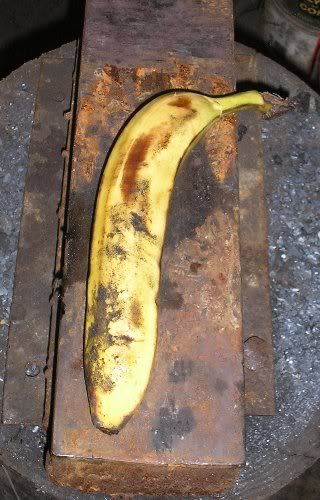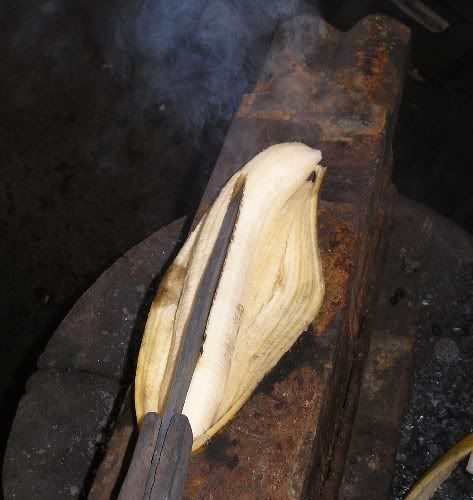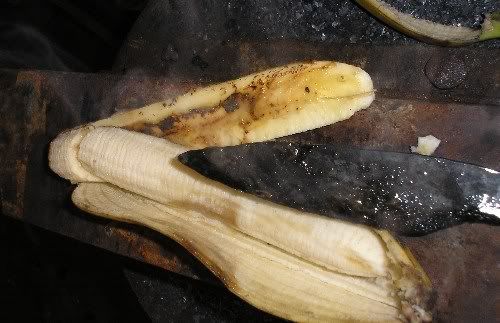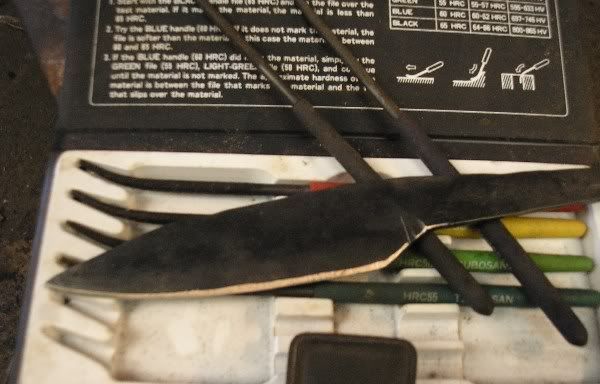I sent out the April issue of my newsletter last night adn I include a little bit called 'tips and tricks'. Normally I just give a hints on polishing, fitting a guard, sharpening or wotnot. This being April the 1st I thought I should do something a bit silly, seemingly possible but highly improbable.
So I came up with the idea of the ulitimate in biodegradable and portable quenchants. Fruit and veg!
This Is what I published:
The only reason I'm coming clean now and not this evening is becuase I thought it would be funnier if I included somoe pics to go with it So this morning I went down to the workshop to take the photos. I forged a blade from a piece of 1/2" round EN45 that was sitting there doing nothiing useful. Then hardened it in a banana.
So this morning I went down to the workshop to take the photos. I forged a blade from a piece of 1/2" round EN45 that was sitting there doing nothiing useful. Then hardened it in a banana.
here are the pics
[HIDE]
 [/HIDE]
[/HIDE]
the banana
[HIDE]
 [/HIDE]
[/HIDE]
the banana unzipped and ready for action!
[HIDE]
 [/HIDE]
[/HIDE]
The Blade being hardened!
[HIDE]
 [/HIDE]
[/HIDE]
Post quench shot, showing the banana line I have to say the smell was very tastey!
I have to say the smell was very tastey!
[HIDE]
 [/HIDE]
[/HIDE]
After a quick clean and a grinding on the edge, toreveal a clean bit of steel, I tested with the files
While cleaning up the surface with the wire wheel, I noticed the telltale signs of a range hardened blade (the scale comes off differently). So I ACTUALLY did test it with the hardness files. The edge came out at between 62 and 64RC! :O You can even see a temper line in the photo! :O
So, my april fool gag kinda went wrong, but at least I found a new quechant
So I came up with the idea of the ulitimate in biodegradable and portable quenchants. Fruit and veg!

This Is what I published:
For this edition, Heat Treating with fruit
When choosing a quenching medium for you steel you need to consider the type of steel that you are using and the geometry of the blade. Some steels are designed to be quenched in oil, some in air, some water and some brine. Often if you quench a blade shape (especially a thin blade) in a medium that is fast it will warp or crack, even if that's what it is supposed to be used with simply becuase of the shape. I've had lots of blades crack in water, even though the steel I use is a water hardening steel, so I quench in oil as it's more gentle but still gives the results i want.
When I'm at shows I take a box of tallow with me, it works the same as oil when melted, but sets when cool, which makes it easier to transport. There are some makers who use a 'goop' quench, this is a mix of oil and solid fats that form a thick goop. The goop quench is ideally suited to edge quenching blades as it will sit in a tray without spilling, but is soft enough to plunge the blade edge into. Edge quenching, for those that don't know, is a technique whereby only the edge of the blade is hardened. This allows you to leave the edge quite hard and improve the overall toughness of the blade. I use this technique with my larger blades and small blades of certain steels (i have other ways of skinning that cat ;-) )
Anyway, to the point. Goop quenches and the tallow are very portable, but are smelly to use and not very environmentally friendly to dispose of. So I struck upon the idea of a 'Fruit Quench'. Instead of using a tray of oil or goop, I use a banana for small oil quenching blades and a marrow for larger knives and those that can stand a water quench. Sounds daft, but the texture and level of moisture/sugars in the banana are just about right to get a high carbon tool steel (such as O1) nice and hard without it cracking or warping! If the blade is quite thick (over 1/4") or too large for the banana then I've found a marrow better. The marrow is almost pure water, but the texture of it slows the quench just enough to prevent cracking (haven't tried it with large thin blade, so beware there). This quenchant is even more portable, environmentally friendly, easily bought and it's disposable (infact, if you pick any scale out you have a nicely caramalised centre to the banana!).
To use the fruit/veg quench simply unzip the banana or slice the marrow in half lengthwise. I'm sure melons, courgettes and aubergines would work too. Once the balde is inserted into the quench, you need to move it back and forth in a slicing motion so that a barrier of warm fruit doesn't form and prevent the blade form hardening fully. The blade will come out cleaner than with oil, but with strangley pleasing colour and smell to it.
Temper as normal in the oven or use the same piece of fruit as a heat sink when heating the spine with a torch (this is a soft back draw and works in a similar way to the edge quench).
Happy heat treating!
The only reason I'm coming clean now and not this evening is becuase I thought it would be funnier if I included somoe pics to go with it
here are the pics
[HIDE]

the banana
[HIDE]

the banana unzipped and ready for action!
[HIDE]

The Blade being hardened!
[HIDE]

Post quench shot, showing the banana line
[HIDE]

After a quick clean and a grinding on the edge, toreveal a clean bit of steel, I tested with the files
While cleaning up the surface with the wire wheel, I noticed the telltale signs of a range hardened blade (the scale comes off differently). So I ACTUALLY did test it with the hardness files. The edge came out at between 62 and 64RC! :O You can even see a temper line in the photo! :O
So, my april fool gag kinda went wrong, but at least I found a new quechant


